Numerical Investigation of the Effect of Symmetry on Evaporation Triggered Elastocapillary Top-Gathering of High Aspect Ratio Micropillars
Abstract
:1. Introduction
2. Numerical Method
3. Results and Discussion
4. Conclusions
Supplementary Materials
Author Contributions
Funding
Institutional Review Board Statement
Informed Consent Statement
Data Availability Statement
Conflicts of Interest
References
- Cassie, A.B.D.; Baxter, S. Wettability of porous surfaces. Trans. Faraday Soc. 1944, 40, 546–551. [Google Scholar] [CrossRef]
- Wenzel, R.N. Resistance of solid surfaces to wetting by water. Ind. Eng. Chem. 1936, 28, 988–994. [Google Scholar] [CrossRef]
- Sojoudi, H.; Kim, S.; Zhao, H.; Annavarapu, R.K.; Mariappan, D.; Hart, A.J.; McKinley, G.H.; Gleason, K.K. Stable Wettability Control of Nanoporous Microstructures by iCVD Coating of Carbon Nanotubes. ACS Appl. Mater. Interfaces 2017, 9, 43287–43299. [Google Scholar] [CrossRef] [PubMed] [Green Version]
- Bonab, M.S.; Minetti, C.; Iorio, C.S.; Zhao, D.; Liu, Q.-S.; Ou, J.; Kempers, R.; Amirfazli, A. Experimental Investigation of Dropwise Condensation Shedding by Shearing Airflow in Microgravity Using Different Surface Coatings. Langmuir 2022, 39, 64–74. [Google Scholar] [CrossRef] [PubMed]
- Xia, Y.; Whitesides, G.M. Soft lithography. Annu. Rev. Mater. Sci. 1998, 28, 153–184. [Google Scholar] [CrossRef]
- Zhang, Y.; Lo, C.-W.; Taylor, J.A.; Yang, S. Replica Molding of High-Aspect-Ratio Polymeric Nanopillar Arrays with High Fidelity. Langmuir 2006, 22, 8595–8601. [Google Scholar] [CrossRef]
- Li, X.; Tao, D.; Lu, H.; Bai, P.; Liu, Z.; Ma, L.; Meng, Y.; Tian, Y. Recent developments in gecko-inspired dry adhesive surfaces from fabrication to application. Surf. Topogr. Metrol. Prop. 2019, 7, 023001. [Google Scholar] [CrossRef]
- Ke, Y.; Chen, J.; Lin, G.; Wang, S.; Zhou, Y.; Yin, J.; Lee, P.S.; Long, Y. Smart Windows: Electro-, Thermo-, Mechano-, Photochromics, and Beyond. Adv. Energy Mater. 2019, 9, 1902066. [Google Scholar] [CrossRef]
- Kim, S.; Sojoudi, H.; Zhao, H.; Mariappan, D.; McKinley, G.H.; Gleason, K.K.; Hart, A.J. Ultrathin high-resolution flexographic printing using nanoporous stamps. Sci. Adv. 2016, 2, e1601660. [Google Scholar] [CrossRef] [Green Version]
- Mariappan, D.D.; Kim, S.; Boutilier, M.S.H.; Zhao, J.; Zhao, H.; Beroz, J.; Muecke, U.; Sojoudi, H.; Gleason, K.K.; Brun, P.-T.; et al. Dynamics of Liquid Transfer from Nanoporous Stamps in High-Resolution Flexographic Printing. Langmuir 2019, 35, 7659–7671. [Google Scholar] [CrossRef]
- Hansson, J.; Yasuga, H.; Haraldsson, T.; van der Wijngaart, W. Synthetic microfluidic paper: High surface area and high porosity polymer micropillar arrays. Lab Chip 2015, 16, 298–304. [Google Scholar] [CrossRef] [PubMed] [Green Version]
- Mohammadian, B.; Annavarapu, R.K.; Raiyan, A.; Nemani, S.K.; Kim, S.; Wang, M.; Sojoudi, H. Delayed Frost Growth on Nanoporous Microstructured Surfaces Utilizing Jumping and Sweeping Condensates. Langmuir 2020, 36, 6635–6650. [Google Scholar] [CrossRef] [PubMed]
- Mousavi, F.; Adibi, P.; Abedini, E. Numerical investigation of surface roughness effect on pool boiling heat transfer of Al2O3/water nanofluid. Proc. Inst. Mech. Eng. Part C J. Mech. Eng. Sci. 2021, 236, 1535–1549. [Google Scholar] [CrossRef]
- Becker, K.P.; Chen, Y.; Wood, R.J. Mechanically Programmable Dip Molding of High Aspect Ratio Soft Actuator Arrays. Adv. Funct. Mater. 2020, 30, 2107062. [Google Scholar] [CrossRef]
- Jiang, Q.; Li, R.; Wang, F.; Shi, X.; Chen, F.; Huang, Y.; Wang, B.; Zhang, W.; Wu, X.; Wei, F.; et al. Ultrasensitive Airflow Sensors Based on Suspended Carbon Nanotube Networks. Adv. Mater. 2022, 34. [Google Scholar] [CrossRef] [PubMed]
- Hu, H.; Wang, D.; Tian, H.; Huang, Q.; Wang, C.; Chen, X.; Gao, Y.; Li, X.; Chen, X.; Zheng, Z.; et al. Bioinspired Hierarchical Structures for Contact-Sensible Adhesives. Adv. Funct. Mater. 2021, 32. [Google Scholar] [CrossRef]
- Barghi, F.; Entezari, M.; Chini, S.; Amirfazli, A. Effect of initial wetting state on plastron recovery through heating. Int. J. Heat Mass Transf. 2020, 156, 119705. [Google Scholar] [CrossRef]
- Barghi Golezani, F.; Abou Yassine, A.H.; Sojoudi, H. Impact Dynamics of Natural Snowflakes on Engineered Surfaces; Bulletin of the American Physical Society; APS: Indianapolis, IN, USA, 2022. [Google Scholar]
- Sim, S.; Jo, E.; Kang, Y.; Chung, E.; Kim, J. Highly Sensitive Flexible Tactile Sensors in Wide Sensing Range Enabled by Hierarchical Topography of Biaxially Strained and Capillary-Densified Carbon Nanotube Bundles. Small 2021, 17, 2105334. [Google Scholar] [CrossRef]
- Ghosh, T.; Fritz, E.-C.; Balakrishnan, D.; Zhang, Z.; Vrancken, N.; Anand, U.; Zhang, H.; Loh, N.D.; Xu, X.; Holsteyns, F.; et al. Preventing the Capillary-Induced Collapse of Vertical Nanostructures. ACS Appl. Mater. Interfaces 2022, 14, 5537–5544. [Google Scholar] [CrossRef]
- Hu, Y.; Yuan, H.; Liu, S.; Ni, J.; Lao, Z.; Xin, C.; Pan, D.; Zhang, Y.; Zhu, W.; Li, J.; et al. Chiral Assemblies of Laser-Printed Micropillars Directed by Asymmetrical Capillary Force. Adv. Mater. 2020, 32, e2002356. [Google Scholar] [CrossRef]
- Kim, I.; Mun, J.; Hwang, W.; Yang, Y.; Rho, J. Capillary-force-induced collapse lithography for controlled plasmonic nanogap structures. Microsyst. Nanoeng. 2020, 6, 65. [Google Scholar] [CrossRef] [PubMed]
- Annavarapu, R.K.; Kim, S.; Wang, M.; Hart, A.J.; Sojoudi, H. Explaining Evaporation-Triggered Wetting Transition Using Local Force Balance Model and Contact Line-Fraction. Sci. Rep. 2019, 9, 405. [Google Scholar] [CrossRef] [PubMed] [Green Version]
- Chandra, D. Capillary Force in High Aspect-Ratio Micropillar Arrays. Ph.D. Thesis, University of Pennsylvania, Philadelphia, PA, USA, 2009. [Google Scholar]
- Chandra, D.; Yang, S. Stability of High-Aspect-Ratio Micropillar Arrays against Adhesive and Capillary Forces. Acc. Chem. Res. 2010, 43, 1080–1091. [Google Scholar] [CrossRef] [PubMed]
- Chandra, D.; Yang, S. Capillary-Force-Induced Clustering of Micropillar Arrays: Is It Caused by Isolated Capillary Bridges or by the Lateral Capillary Meniscus Interaction Force? Langmuir 2009, 25, 10430–10434. [Google Scholar] [CrossRef] [PubMed]
- Kang, S.H.; Pokroy, B.; Mahadevan, L.; Aizenberg, J. Control of Shape and Size of Nanopillar Assembly by Adhesion-Mediated Elastocapillary Interaction. ACS Nano 2010, 4, 6323–6331. [Google Scholar] [CrossRef] [Green Version]
- De Volder, M.; Hart, A.J. Engineering Hierarchical Nanostructures by Elastocapillary Self-Assembly. Angew. Chem. Int. Ed. 2013, 52, 2412–2425. [Google Scholar] [CrossRef] [Green Version]
- Kim, T.-H.; Kim, J.; Kim, H.-Y. Evaporation-driven clustering of microscale pillars and lamellae. Phys. Fluids 2016, 28, 022003. [Google Scholar] [CrossRef] [Green Version]
- Kim, M.; Yoo, S.; Jeong, H.E.; Kwak, M.K. Fabrication of Salvinia-inspired surfaces for hydrodynamic drag reduction by capillary-force-induced clustering. Nat. Commun. 2022, 13, 5181. [Google Scholar] [CrossRef]
- Siéfert, E.; Hua, H.-A.B.; Brau, F. Capillary coalescence of two partially immersed slender structures. Extreme Mech. Lett. 2022, 55, 101823. [Google Scholar] [CrossRef]
- Dhar, P.; Jana, R. Menisci evaporation of electrokinetic liquid-film flows within inclined micro-confinements. Phys. Fluids 2022, 34, 042002. [Google Scholar] [CrossRef]
- Kralchevsky, P.; Paunov, V.; Ivanov, I.; Nagayama, K. Capillary meniscus interaction between colloidal particles attached to a liquid—Fluid interface. J. Colloid Interface Sci. 1992, 151, 79–94. [Google Scholar] [CrossRef]
- Shi, Z.; Jefimovs, K.; Stampanoni, M.; Romano, L. High aspect ratio arrays of Si nano-pillars using displacement Talbot lithography and gas-MacEtch. arXiv 2022, arXiv:2209.13672. [Google Scholar] [CrossRef]
- Pokroy, B.; Kang, S.H.; Mahadevan, L.; Aizenberg, J. Self-Organization of a Mesoscale Bristle into Ordered, Hierarchical Helical Assemblies. Science 2009, 323, 237–240. [Google Scholar] [CrossRef] [PubMed] [Green Version]
- Charpentier, J.-B.; de Motta, J.C.B.; Ménard, T. Capillary phenomena in assemblies of parallel cylindrical fibers: From statics to dynamics. Int. J. Multiph. Flow 2020, 129, 103304. [Google Scholar] [CrossRef]
- Garcia-Gonzalez, D.; Snoeijer, J.H.; Kappl, M.; Butt, H.-J. Onset of Elasto-capillary Bundling of Micropillar Arrays: A Direct Visualization. Langmuir 2020, 36, 11581–11588. [Google Scholar] [CrossRef]
- Beer, F.P.; Johnston, E.R., Jr.; DeWolf, J.T.; Mazurek, D.F. Statics and Mechanics of Materials; McGraw-Hill Education: New York, NY, USA, 2017. [Google Scholar]
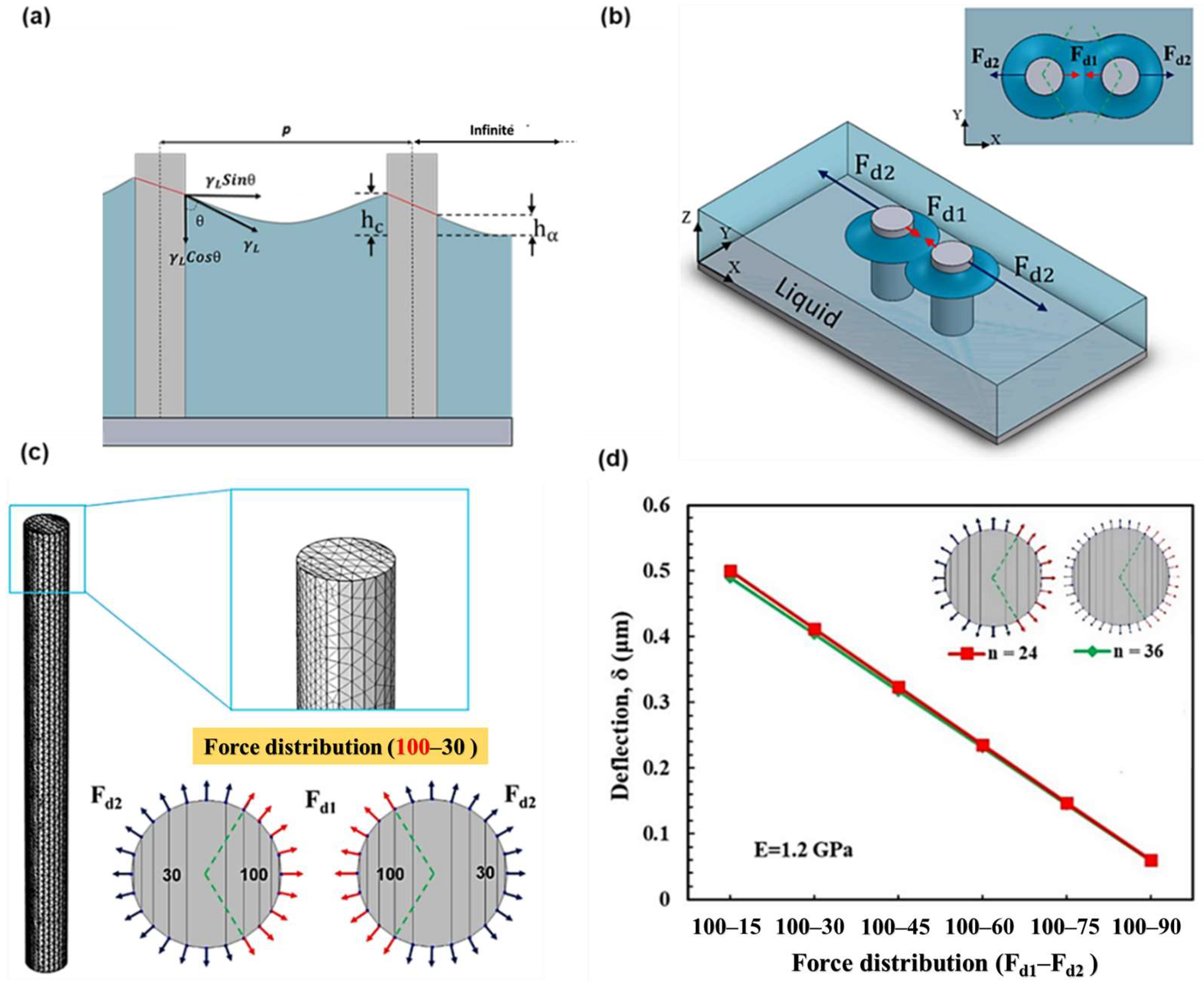
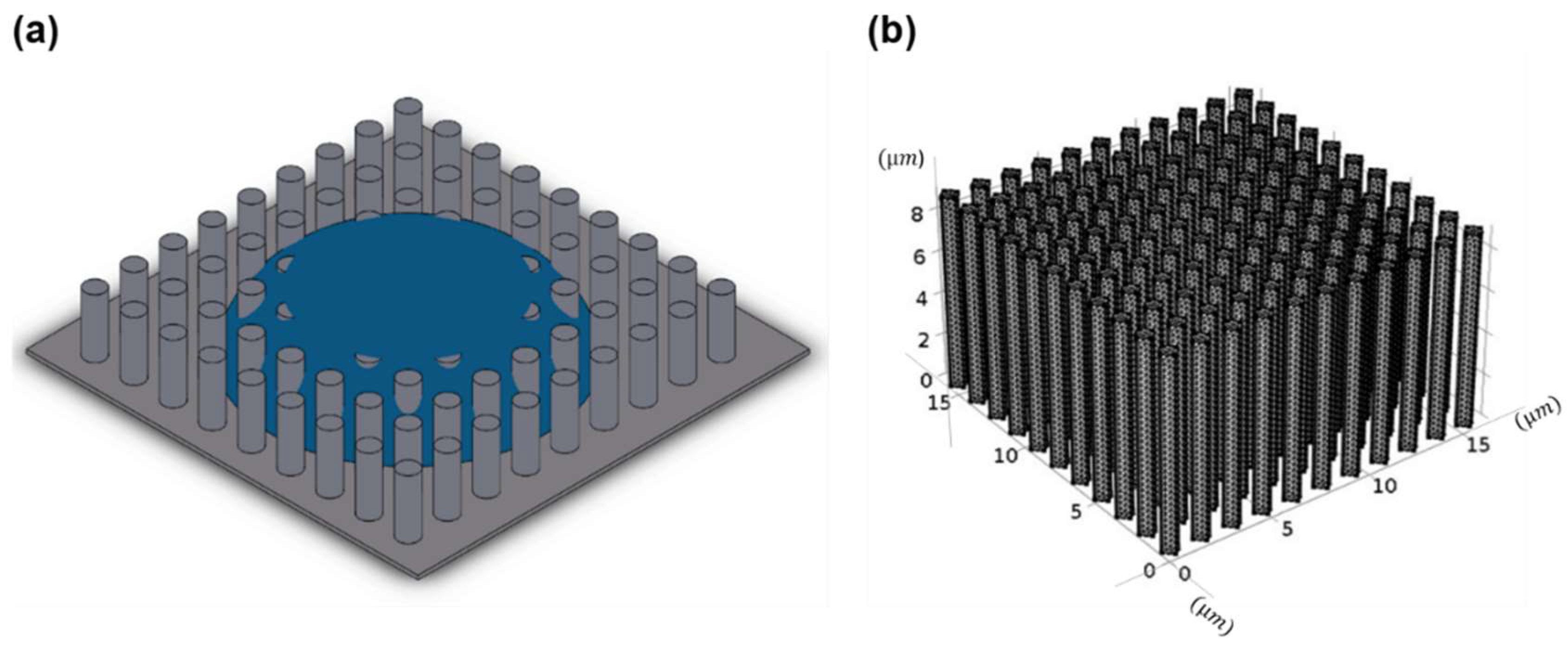
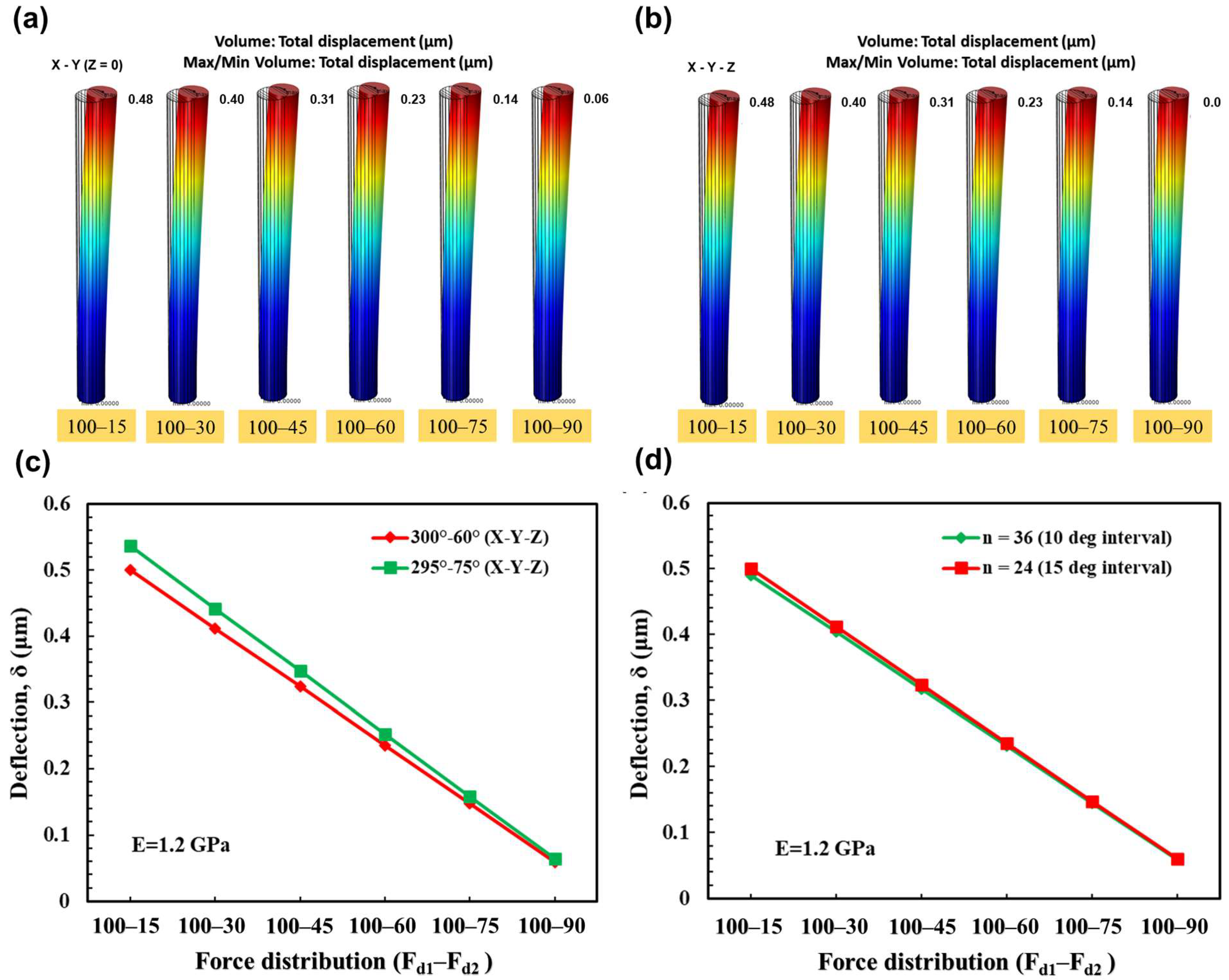
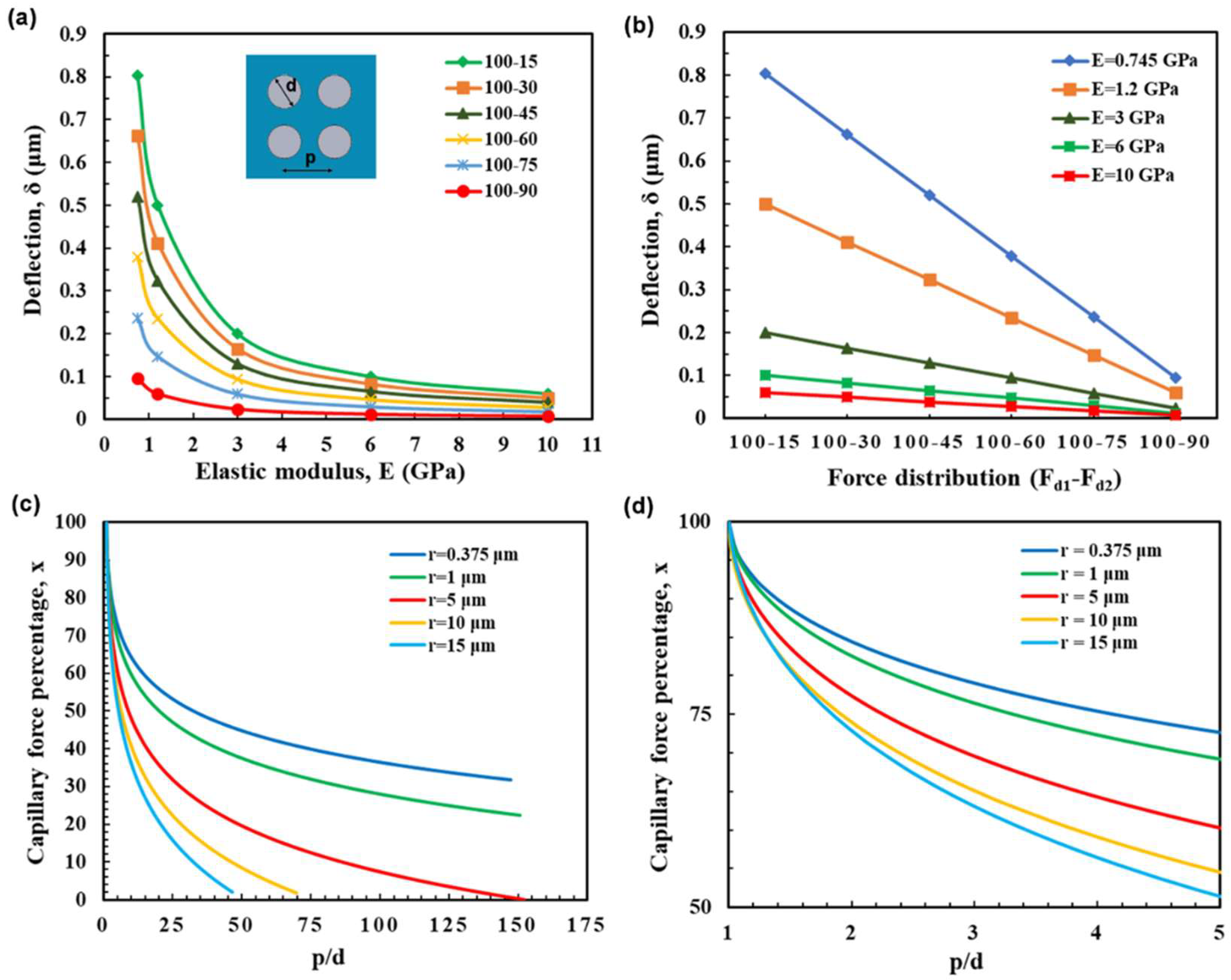
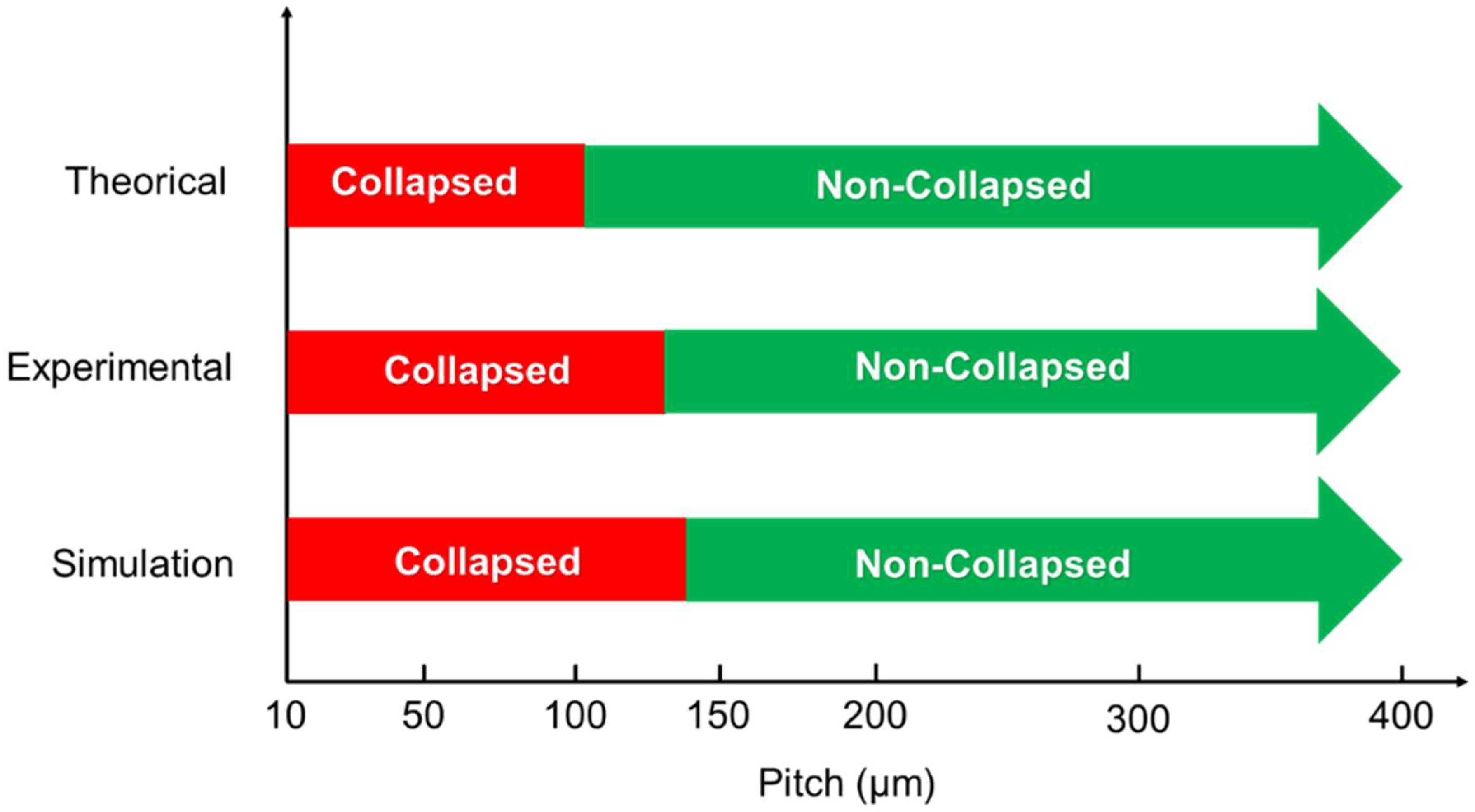
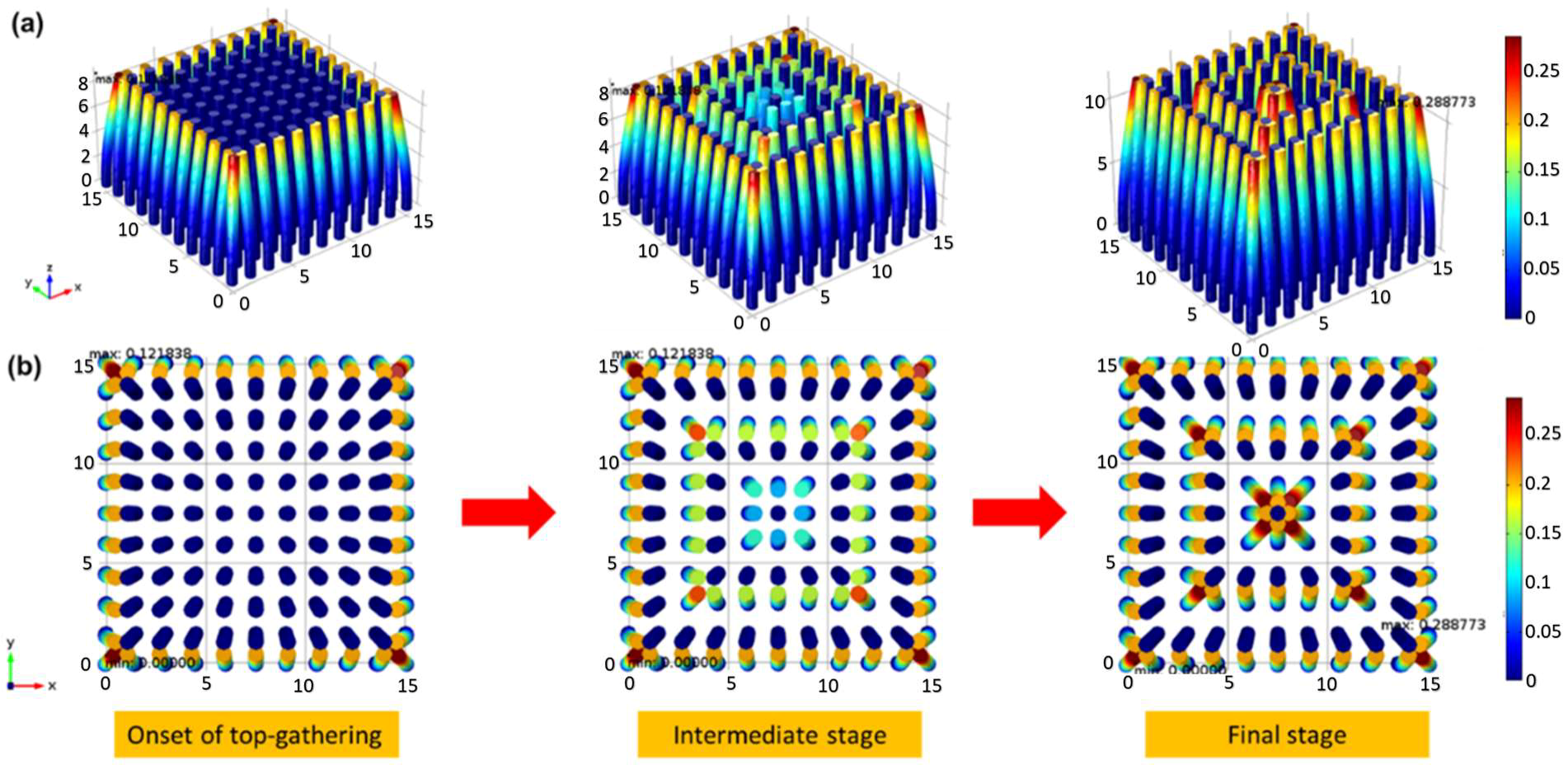
Disclaimer/Publisher’s Note: The statements, opinions and data contained in all publications are solely those of the individual author(s) and contributor(s) and not of MDPI and/or the editor(s). MDPI and/or the editor(s) disclaim responsibility for any injury to people or property resulting from any ideas, methods, instructions or products referred to in the content. |
© 2023 by the authors. Licensee MDPI, Basel, Switzerland. This article is an open access article distributed under the terms and conditions of the Creative Commons Attribution (CC BY) license (https://creativecommons.org/licenses/by/4.0/).
Share and Cite
Barghi Golezani, F.; Kishore Annavarapu, R.; Sojoudi, H. Numerical Investigation of the Effect of Symmetry on Evaporation Triggered Elastocapillary Top-Gathering of High Aspect Ratio Micropillars. Coatings 2023, 13, 292. https://doi.org/10.3390/coatings13020292
Barghi Golezani F, Kishore Annavarapu R, Sojoudi H. Numerical Investigation of the Effect of Symmetry on Evaporation Triggered Elastocapillary Top-Gathering of High Aspect Ratio Micropillars. Coatings. 2023; 13(2):292. https://doi.org/10.3390/coatings13020292
Chicago/Turabian StyleBarghi Golezani, Farshad, Rama Kishore Annavarapu, and Hossein Sojoudi. 2023. "Numerical Investigation of the Effect of Symmetry on Evaporation Triggered Elastocapillary Top-Gathering of High Aspect Ratio Micropillars" Coatings 13, no. 2: 292. https://doi.org/10.3390/coatings13020292
APA StyleBarghi Golezani, F., Kishore Annavarapu, R., & Sojoudi, H. (2023). Numerical Investigation of the Effect of Symmetry on Evaporation Triggered Elastocapillary Top-Gathering of High Aspect Ratio Micropillars. Coatings, 13(2), 292. https://doi.org/10.3390/coatings13020292






